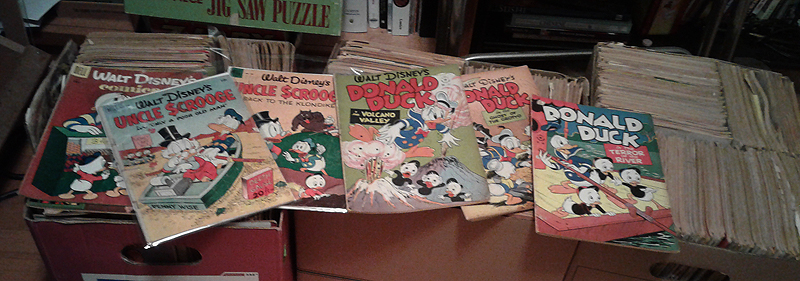Just there on the office floor are 3 good sized boxes of comics. They are there because a friend of my nephew’s passed away and willed him his collection. They are Golden Age comics. That is from the 40’s, 50’s and early 60’s. There are several holy grails of comic art in there. In particular, for me at least, a 1952 issue of Walt Disney’s Comic and Stories. This issue came in the mail when I was 5. I could not read. Ran all over the house pleading for someone to read it to me. All my normal readers were busy except grandma who was visiting from Salt Lake. Could she read? She’s so old. Boy could she. She had a remarkable voice. Had a hint of frog in it. She read me the thing, us sitting on the edge of my bed. I never forgot. I am writing this as a direct result of that little episode.
Seventeen years later a friend and I are taking a drive north from Vallejo, Ca. We stop at a little store for snacks. I see a comic book rack. I buy a Walt Disney’s Comics and Stories for 12 cents. It is the same story, reprinted. I bought it and read it for myself this time. I began buying them monthly and eventually acquired great piles of the things. I became a cartoonist sculptor. That particular artist was Carl Barks who passed away 17 years ago at the age of 99. Carl was from Merrill, Oregon and worked as a writer for the early Donald Duck cartoons. After a strike at Disney in 1941, he began working as the Duck cartoonist for Dell Publishing. He was very good and very prolific.
Why does this matter? What does it have to do with sculpture? Beyond Barks’ storytelling was the drawing, the lines, expressions and gestures. They were all dead on. Alive. In most studios where cartoons are pumped out by the bucket load are model sheets pasted to the wall.
If you want to draw something lifeless use one of those. The thing that made Bark’s drawing so good is that every expression or gesture is unique to the situation. If the expression is just right then you not only get it but you feel it. You know exactly what that particular curve in that line means deep down. To get this right is a bit like method acting. You have to feel it, you have to be that as you draw it. This applies to sculpting as well. It’s like being one with what you are doing.
Humans are adapted to finely interpret facial and body expressions. There are shades of meaning in a facial expression that can change with just the teensiest nudge of a lip line. It’s a complex language all its own which we understand right from birth. The lines themselves can have meaning, such that the shape of a line on a face when applied to the curve of an abstract sculpture conveys some of the original meaning. Car makers know this and if you’ve ever been tailgated by a ‘53 Buick you know what I’m saying.
Like words, line curves can carry connotations. In this way a simple line can speak directly to one’s emotions whether that line is part of a face or the silhouette of a sculpture.

Leave a Reply
You must be logged in to post a comment.